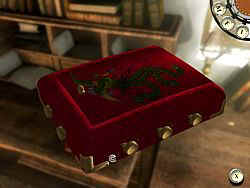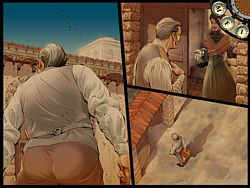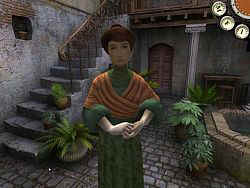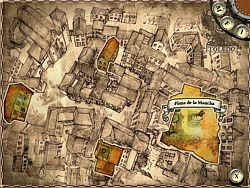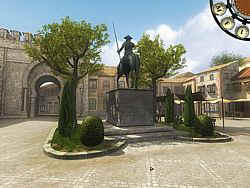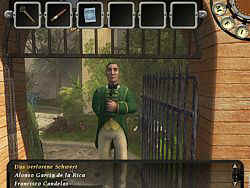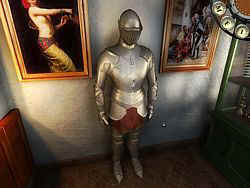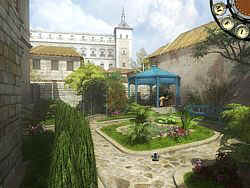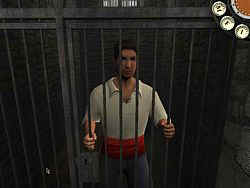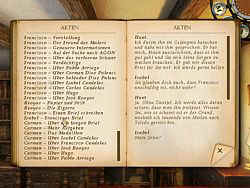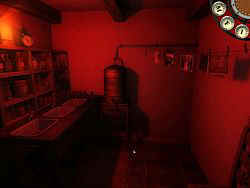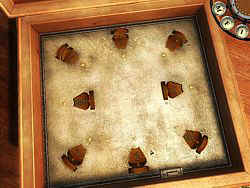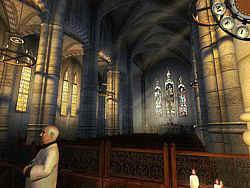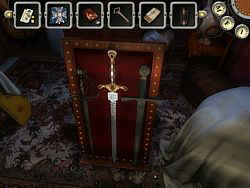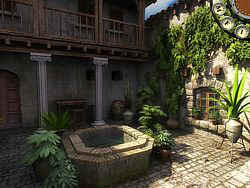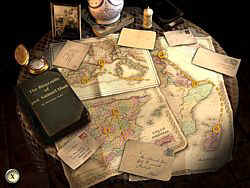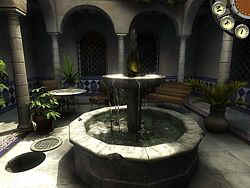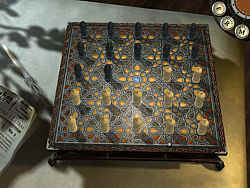Back to Adventure-Archiv starting page
| Agon
4 - The Lost Sword of Toledo
Publisher: Microapplication / CDV / Kalypso Game language: German
USK: no restriction
A review by Jehane April 19th 2008
It’s quite a task the Hungarian Private Moon Studios are planning to carry out with Agon: In the end, the story will have no less than 14 episodes, each episode causing our hero to travel to a different country. Everywhere he goes, puzzles will provide clues to the mysterious lost game of Agon; our hero will have to find long forgotten board games and break the curses associated with these games and the families which guard them. Agon – The Lost Sword of Toledo is part four in the series which initially was provided via download but finally made it to the shelves. If you like, you can still download the individual episodes from the producer’s website.
Story Missed the earlier episodes? No problem: The main menu provides a short summary of the story so far; thus, The Lost Sword of Toledo is also a game for those who missed out on the first three episodes. The fourth installment’s story can also stand alone – the story’s core, the search for the mysterious game of Agon, is provided with a sophisticated and exciting background story, combining crime, a great deal of mystery and a delicate love story. Let’s recapitulate: Professor Samuel Hunt, staff member of the British Museum in London, by accident finds a mysterious letter and an equally mysterious codex which seems to be connected with a statue and several board games. These board games are in the possession of several families – Professor Hunt needs to find those families, break the curse associated with the board game and learn how to play that game. In episodes 1-3 – episode 1 is more like a prologue to the actual story – Hunt was able to acquire two board games, three pages of the codex and three granite slabs which are part of the statue and seem to form a puzzle. Hunt’s next stop is the Spanish town Toledo, famous for its sharp blades. Here everything is a little different, time seems to slow down. Toledo is also the hometown of the family Candelas, the Candelas being the owners of the next board game. Upon his arrival, however, Professor Hunt must discover that his contact person, painter Salvador Diaz Palencia, has died a year ago. The only surviving member of the family, the artist’s daughter Carmen, is stuck between a rock and a hard place – her father has promised nobleman Alonso Garcia de la Rica that his son Eugenio shall become Carmen’s husband in case Carmen isn’t married when turning 21. Of course, Carmen is not amused – her heart belongs to young Francisco Candela. Yes, that’s right; an offspring of the same family Professor Hunt set out to visit. To make things even more complicated, Francisco is in prison; he is accused of having stolen a valuable sword forged by his grandfather. The sword, though an heirloom of the Candela family, has somehow turned up in the Garcia de la Rica household. It’s upon Professor Hunt to shed light on all these mysteries before Francisco can teach him the next board game, Alquerque, and before he can continue his journey. The story smoothly ties in with the predecessors but seems to be set a year later; time specifications are not given in this installment of the series. However, various comments and clues within the game and "Dorothy’s table" (main menu) suggest that the year is 1904. By concentrating on the search for the lost sword and the numerous subplots revolving around the families Diez Palencia, Garcia de la Rica, and Candela, the Agon itself is being pushed into the background; thus, the episode definitely as an individual game which requires no previous knowledge. In terms of story, playing time, and puzzles, the game is much more intricate and appealing – when reaching the end, you definitely want more! When composing the story, the developers obviously paid attention to all the little details and environment – being a scholarly professor, you of course get to read tons of books and documents, most of these providing you with more information about other persons, history of art, and alchemy. You don’t have to read all texts that pop up – not all of them are relevant for the game – but I’d advise you do read them – the game gains so much more depth and appeal! If you like, you can, for example, read a couple of pages from "Don Quixote", study medieval books on magic or renew your astronomical knowledge. That’s right: The story becomes, at points, magical and mysterious! Although you don’t have to expect spectacular plot twists or an exciting ending sequence, this game will have you glued to the screen until the end, trying as Professor Hunt to shed some light on the mysteries and beat the numerous puzzles that get in your way.
Installation/Tech Stuff/Design In terms of design, the game follows its predecessor, "The Mysterious Codex" (containing the first 3 episodes) closely: The DVD comes in a small box that has been designed like the first one but given warmer colours, thus adapting to the new environment Professor Hunt moves in. Installing the game is easy and swift; on my computer, the game ran smoothly without any problems whatsoever. However, there were reports about a bug that causes the game to crash; I didn’t encounter this bug but maybe I was just lucky – I had to leave the respective building (the forge) and re-enter it quickly in order to carry out a specific task, thus probably avoiding the bug. As I said, the game ran smoothly on my computer; it’s alt-tab-friendly which is especially helpful when making screenshots. And at one point in the game, you might want to do just that. A short note on the manual: Money was saved here – thoroughly. The Lost Sword of Toledo contains exactly the same manual as The Mysterious Codex, only the cover was altered. Not only the content but also every single mistake were transfered. The sections "Clues", "Credits" and "Comments", supposedly in the last section of the manual, are missing alltogether – as they were in the manual for The Mysterious Codex. This is very sloppy work; a little more care would have been preferable. Also, some colour would have been nice; instead, the manual is layouted in boring black/white.
Controls and Handling The game is a First-Person-Game, meaning that we see Prof. Hunt only during cutscenes. Prof. Hunt is steered throughout the game by using the mouse; the controls have been kept very intuitive so the manual is not really needed to understand the controls and handling. Top right you’ll find three buttons: menu, documents, inventory. The latter appears on the upper part of the screen when clicking the corresponding button. An arrow pointing straight ahead indicates that you can move in this direction; you move through beautifully rendered fixed images – sadly, freedom of movement was restricted, even though you can pan 360 degrees. Free exploration of sunny Toledo, thus, is not possible. To turn, you need to hold down the left mouse button; if you forget to do so, it might well happen that you end up in front of a bookshelf with no idea how to exit that point of view. In this case, the cursor retains the shape of a small triangle which indicates that there’s nothing you can actually do here. In addition to the arrow pointing straight ahead, there’s a small arrow with a sort of compass below it. This appears every time when you leave a location. Clicking it makes Prof. Hunt leave the current location and go to a map of Toledo which is being filled with locations as you progress. These locations are highlighted in a warm orange hue; to get there, all you need to do is click on them. If a location is no longer needed, it disappears from the map resp. loses its colour and takes on a grey hue that dominates the map. Additional cursors include a gear for actions, a magnifying glass for examination, a hand to take something, and a speech bubble whenever it is possible to talk to another person. With some puzzles, you’ll also have arrows pointing left or right, indicating that something like a small wheel can be turned in the corresponding direction or indicating that you can turn the pages of a book. These arrows can also rotate, indicatin that you can turn something such as a button or lever. Texts in books or letters can be read either in English or, if you’re too lazy to do so or if your command of English is not that perfect, you can resort to the integrated translation. Just move the mouse over the text you want to read; the text then will be highlighted, and the translation will be shown above the original text, using a lucent background so that original text and translation overlap. Not very comfortable to read; this could have been done better. The translations, by the way, are not always literal, but this can be said to be poetic license. However, it doesn’t derogate the overall impression of the game. To save the game, you need to click on the menu button top right; there are, as in the predecessors, eight slots for saving games. This is not an awful lot, especially if you like to save very often – you never know what’s around the next corner, right? Agon, however, is not a game that includes death sequences. On my computer, it ran pretty smoothly – no crashes, no bugs. Thus, frequent saving wasn’t necessary. Anyway. Restricting the slots for saving games should by nowadays be a thing of the past. Via the menu, you can also load a game; savegames are shown with a picture of the current location, date and time of day which, of course, makes navigation a little easier. When starting the game up, you need to click on "continue" – hey presto, you’re at the exact spot you left the game, thanks to autosave. If you wish to continue with one of your savegames, just load it; this is only possible during playing.
Inventory The inventory can be found top right and is summoned by clicking the corresponding button. As you progress, the inventory fills up with lots of useful items; to browse through them, use the arrows provided right and left. Some items show a gear; these can be analyzed, combined, or given to another character by using the right mouse button. If you pick up an item to use it outside the inventory, it is outlined, thus indicating that an action is possible – this, however, does not mean that you can actually perform the action or that you already have everything you need. But you’re on the right track. If you move the mouse over an item, you’ll get a short description. The button for documents (F for files) is also part of the inventory. Here you’ll find all conversations the Professor has had in Toledo – very useful because conversations often contain hints what to do next or how to solve a certain puzzle. An extension of the notebook would have been desirable when it comes to a certain puzzle; we’ll return to that later.
Graphics Not only with regard to the story but also graphically, the game smoothly follows up to its predecessors. In the beginning, you get to enjoy beautifully done opening credits summing up the Professor’s journey so far. When starting a new game, you’ll see an equally beautiful opening sequence: There’s a carriage being painted with a few strokes of the brush, gradually filling up with colour just like the environments. After that, there’s a fixed image followed by a moving image; you’ll end up in the carriage with Prof. Hunt who’s writing a letter to his wife Dorothy, telling her about his journey so far. Then, you’ll arrive in Toledo, being welcomed by warm colours and a lot of sunshine. The warm colours dominate throughout the game, unless, of course, you explore locations that are a little gloomy, such as the city’s sewers. Even in the sewers, there are hints of colour. If, for example, the light of Prof. Hunt’s lamp touches a wall, the wall will become brightly orange. I must admit I have explored sewers much more disagreeable and much more uncomfortable sewers in other adventure games. Thanks to stunning graphics, warm colours and sunbeams, you cannot help but want to sit down at one of the tables in Plaza de la Mancha, sip a glass of good wine and enjoy the sun. Unfortunately, Plaza de la Mancha remains pretty lifeless even though the developers have obviously put an effort into generating some people so that the place is not altogether deserted. However, the farther those persons, the less they move. Sometimes they even feel painted – and they probably are. The individual locations, however, are beautiful and lifelike. Sometimes, textures seem a bit blurry and washed-out. If you can explore these locations, they gain in outline. While "The Mysterious Codex" used cutscenes, you won’t get any of that in this game. Instead, there are beautifully drawn fixed images, comic-style, partially highlighted with dialogue. By pressing the "Escape" button on your keyboard, you can cut off these "cutscenes" – comes in handy at some times, because if you have seen for the umpteenth time how Prof. Hunt opens the gate to the estate of the Diez Palencias estate, you’ve had enough of it for the rest of the game. The same technique was applied in crucial scenes – for example in the case of Prof. Hunt’s self-made photo-trap snapping shut. Instead of an animated cutscene, you get to see comic-like fixed images. At first, I thought this was a shame because these images, though beautifully rendered, deprive the game of some of its flair. On the other hand, they perfectly fitted the oldfashioned style of the game, the latter taking place at the beginning of the 20th century. In those days, there simply were no rapid cutscenes with loads of special effects. It’s in these cutscenes/fixed images that we get to see Prof. Hunt himself – unless, of course, he’s standing right in front of a mirror or window. In contrast to the previous games, the good Professor moves as soon as you move the mouse – I like that kind of effect because it reflects the developers’ care they put into utmost realism. Unlike previous episodes, Prof. Hunt meets a lot of dialogue partners who can help him in solving the mystery. However, the faces of the 3D-persons feel somewhat stiff; in some cases – Carmen, for example – you’ll have a grey vertical line running down the nose, in some cases an additional horizontal line across the forehead. Facial expression remains pretty lifeless even if the person obviously is in pain – for example, Carmen gets to talk about her misery in the beginning, becoming very emotional during recounting her fate. As far as her voice goes, the emotions come across pretty authentic; however, you don’t see any of these emotions in her face – a real shame. For a girl only 21 years old, Carmen also looks awfully old; maybe it’s just her hairdoo. The only exception as far as facial expression goes is Hugo, the French servant. He’s allowed to lift up an eyebrow, thus coming across wonderfully smug – perfect for this kind of character. Similar expressions would have been desirable for other persons in the game. Set off against the beautifully rendered backgrounds, some persons come across as pretty comic-like; their inflexible, smooth faces just don’t match the beautiful backyards with their rippling fountains. The shadows cast by the people are well done as long as the people are in direct sunlight. However, the people Hunt talks to don’t move much; they stay in the exact place all the time. If they move to another location, this is done during Hunt’s absence. Gestures are limited to a few movements, but you get to see how items are exchanged – not a matter of course because in other adventures you don’t get to see the item that is exchanged. As far as lip synchronisation is concerned, I cannot give Agon – The Lost Sword of Toledo full credits. The people’s mouth just open and close along what is being said, leaving an impression of fish breathing. Sometimes, teeth will wander about – this actually looks quite funny, and there are a lot of glitches to be accounted for. For example, a dealer in antiques disappears behind a curtain he doesn’t even move – he just walks through the curtain as if he were a ghost. A musician’s guitar doubles when he’s done playing a song and a piece of pastry, referred to as a biscuit, definitely looks like a muffin – ok, this might just as well be a mistake in translating the game. The jacket of the aforementioned dealer in antiques shows some dark patches when he turns (no, this definitely isn’t some kind of filth – the man is unsoiled!). Let’s now talk about the sound: The catchy theme featured in the first three games was kept unchanged. Additionally, there’s the sound of guitars playing a flamenco, sometimes the music can become very gloomy and dramatic – however, there’s not necessarily danger involved when the music swells to gloomy tunes. Background sounds fit the environments – you hear a dog barking, birds fly by, you hear pigeons coo, and after you’ve entered the forge, you’ll hear the sound of horse hooves nearby. Thus, you’ll always have a feeling of exploring a vibrant city, even though most of its inhabitants seem to be off for a siesta. The speakers are well chosen. Prof. Hunt comes across very composed and respectable (and very british), but even he can get a little excited now and then without losing his composure. Excitement is afoot whenever our dear professor encounters a rare book (that’s your typical academic) or whenever he has found the solution to a particularly difficult puzzle. Carmen Diez Palencia, on the other hand, has a wonderfully gentle voice which carries her emotions very well. Also, her pronounciation of Spanish names is perfect – you cannot say that about the other speakers but they do their best. I didn’t encounter a single person that was not authentic in their role; one highlight definitely was Hugo, the French servant, who spoke with a corresponding accent, thus rendering "harmloser Mann" (harmless man) to "armloser Mann" (armless man) – I laughed out loud at this one. A beautiful idea was having Carmen’s father read a letter to his daugther even though at this point of the story he was dead already. By using this voice from the beyond, you get a pretty good idea of who Salvador Diez Palencia was. Thus even he, though long gone, becomes a lively figure. Somewhat confusing was, I must admitt, the voice of a parrot, the animal being one of Prof. Hunt’s informants: Even though the animal was talking in a clear voice, it had such a vibrating timbre that it reminded me of a certain dictator. This was very confusing, especially since the animal’s dialogue sounded very military ("vorrrwärrrts – rrrrechts – rrrrechts..").
Puzzles Agon – The Lost Sword of Toledo features a number of puzzles, ranging from fairly easy to extremely difficult. The decoding puzzles featured in the previous installments of the series were omitted – that is, those puzzles using an oldfashioned typewriter-interface for entering the solution. To me, this was a relief because in episode 2, the morse puzzle in Lapland left me under the impression of, let’s say, just having been made fun of, mainly because the solution to this puzzle was completely irrelevant to progressing in the game – you can finish episode 2 without ever solving the morse puzzle! What wasn’t always fun in episodes 1-3 has been improved a lot; the puzzles in Lost Sword of Toledo are sometimes refreshingly tricky, always logically embedded and fit the inquisitive character of Prof. Hunt. They are, however, very demanding – as a player, you’ll need an excellent memory, for example when having browsed old books earlier in the game and needing one hint from those books later on to solve a puzzle. At some points, an integrated notebook would have been very helpful – there’s a puzzle involving a kaleidoscope which is, in fact, quite funny and pretty to look at. But in order to figure out which pattern to set up in which tube, you’ll need certain symbols which have been placed all over the town. Even though you’ll have pictures of these symbols, you won’t be able to take them with you to the kaleidoscope to compare the shapes and patterns. In this case, you either rely on your memory – not recommendable given the amount of symbols you’d have to memorize. Or you make screenshots of each individual symbol, print them out and work on the kaleidoscope using the screenshots. However you choose to go about it, it’s a long process; this is a very long, complex and slightly cumbersome puzzle. Of course, Prof. Hunt has to solve other puzzles as well: In the very beginning, you’ll need to open a small box that is locked up with a rather dodgy mechanism. Caution: If you twist and turn the eight buttons long enough, you won’t be able to go back to the status quo, meaning you can’t turn them back in the position they were when you found the box. You won’t be able to solve the puzzle in this case and will have to resort to a savegame; in case you don’t have savegame at this point, you’ll have to start all over! I found this very annoying; the puzzle comes along in the very beginning, during the first minutes of the game – most people won’t have saved the game by then. This is, however, the only puzzle that worked this way. There’s also an old music box that needs to be opened; it is locked with a code. Hints to the various codes (yes, there are more to come!) can be found in dialogues and books. In one case, a code puzzle is linked to a sound puzzle and books resp. textbooks. Some puzzles work on different levels and are quite elaborate – a nice and inspiring challenge that slightly breaks up the linear plot. Also, some puzzles can be solved in an order chosen by the player. Other puzzles necessitate handling chemical substances or the utensils of a blacksmith, you’ll have to solve astronomical challenges, develop photographs, find your way out of a locked chamber or find your way through Toledo’s sewer systems. This maze isn’t half as hard as one might think because in this case, you’ll have a notebook and symbols to help you get through. Once you’ve crossed the sewer systems, you’ll also receive a map of the sewer systems so you can pass through quickly the next time. Later on in the game, there’s a second maze; before you encounter it, you’ll also receive some hints – be sure to write them down or memorize them! The puzzles featured in Agon – The Lost Sword of Toledo are of a broad variety and different levels of difficulty. With some thinking and puzzling, you should be able to find most solutions by yourself, even more so since all puzzles are logically embedded in the game and none leaves you puzzled. Ok, that’s not exactly true – there is a least one logical mistake I encountered when having to calculate a certain date using an eternal calendar. The player’s correct assumptions and conclusions are thrown over by the game because it assumes completely different parameters that are valid to solve the puzzle. This was, however, the only time I was really annoyed with the game because the solution I had come up with was right in principle but the game wouldn’t let me use it. At the end of the game, you’re up to winning another boardgame. This time, however, you can skip it if you find it too hard, a feature that was missing in the three predecessors. You’ll be able to finish the game even though you might not win the boardgame – a very nice feature because the boardgames cost me a lot of time in episodes 1-3 (ok, and the weird puzzle involving wooden poles at the pirate’s grave). After finishing the game, you can go back anytime and replay the boardgame as often as you like.
Dialogues Most dialogues are automatically played, sometimes Prof. Hunt gets the opportunity to choose from a couple of topics. It’s very important to listen to all the dialogue provided in the game – you never know if a person doesn’t have valuable hints that might help you later on. There’s a lot of talking in Agon – The Lost Sword of Toledo, more talking than in the previous episodes combined. I found this very refreshing because the numerous dialouges were a great opportunity to get more insight into Prof. Hunt’s personality which is being reflected wonderfully in the dialogues. To me, the British scholar often came across as a nice, compassionate uncle, unable to harm even a fly but determined to reach his goals by using his intellect. Hunt is an atypical adventure hero – middle-aged, very polite (he’s British, after all) and not necessarily a bundle of energy. But he comes across very likeable, thanks also to the excellently chosen German voice; it’s easy imagining to meet him for a cup of tea and discuss books. The rest of the cast are lively, have personality and are mostly likeable characters – despite their fixed expressions and too-smooth faces. Dialogues you’ve already heard cannot be interrupted if they have to replayed for whatever reason; this could have been changed because some dialogues are pretty long. Some dialogues are optional, for example when you choose to ask another person about a third person – you don’t have to do this if you don’t want to. Most of the information you’ll receive when asking questions about a third person is not relevant for finishing the game but gives you more insight. Also, I enjoyed the dialogue a lot because I just love having the possibility to immerse myself even deeper into the game.
Conclusion The potential that shone through in the previous episodes of Agon is exhausted for the first time in Agon – The Lost Sword of Toledo. The game is convincing both in plot and puzzles; Prof. Hunt, an atypical adventure hero takes your heart easily with his calm, solemn personality. At the end of the game, I would have loved to join him on his next journey; unfortunately, we’ll all have to wait a bit before episode 5 will be released. Some things that made the first episodes a plight were omitted, such as having to enter the correct solution to a puzzle via an oldfashioned keyboard. Also, you can skip the boardgame at the end of the game. As far as play time is concerned, Agon 4 is also convincing – you’ll need at least 15 hours if you plan to join Prof. Hunt in his search for Agon. Thus, episode 4 is as long as the first three epsiodes put together. However, Agon 4 is far from being perfect. Facial expressions and gestures leave a lot to be wished for; some bugs in graphics should be omitted. Some puzzles proved to be a little tedious (kaleidoscope puzzle), at one point there was even a logical error within the game. Difficulty ranges from fairly easy to hard, all puzzles were carefully designed, some are very complex and have multiple layers. The fourth episode fleshes out Agon a lot more than the predecessors; let’s just hope that the standard is being kept for the episodes to come. I, for my part, am looking forward to episode 5 which will be playing in Bejing and is entitled "Tale of the Four Dragons". Rating: 78%
Adventure-Archiv rating system:
System Requirements:
Played with:
Copyright © jehane for Adventure-Archiv, April 19th 2008
Back to Adventure-Archiv starting page
|
 The main menu
|
|
